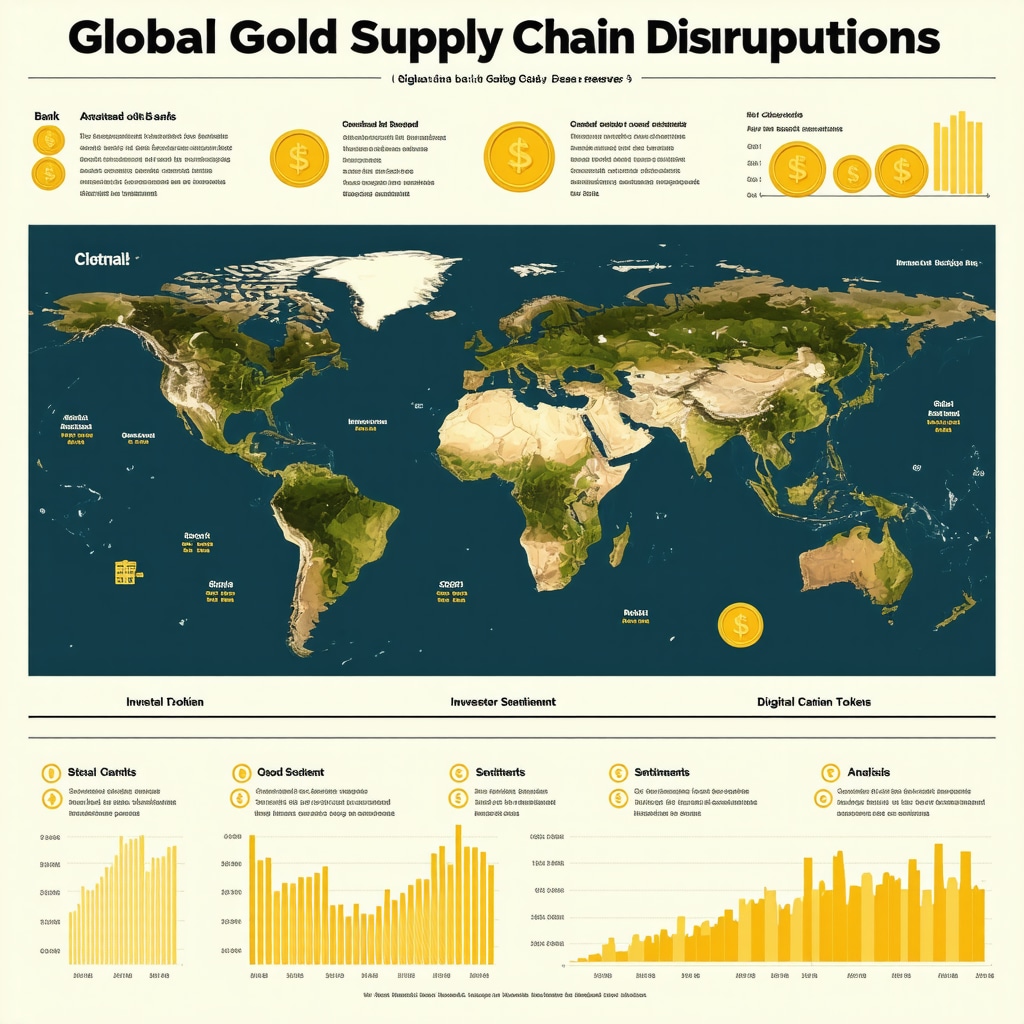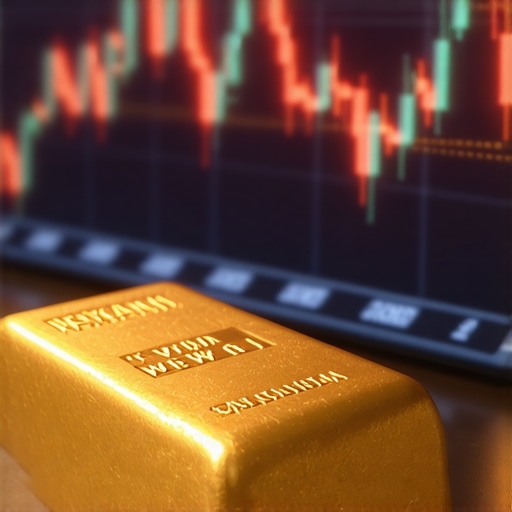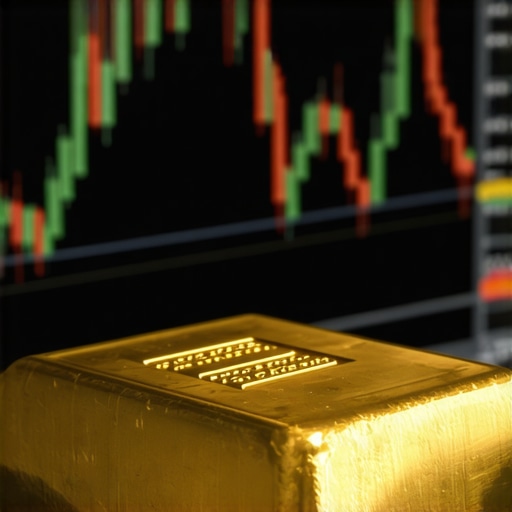Unlocking the Mysteries Behind the 2025 Gold Price Forecast
The allure of gold as a timeless store of value remains unshaken, yet predicting its price movements in 2025 requires more than a glance at historical charts. Investors today grapple with a labyrinth of economic variables, geopolitical tensions, and evolving market dynamics that collectively steer gold’s trajectory. Understanding these multifaceted influences is essential for crafting a savvy investment strategy that capitalizes on gold’s unique role as both a hedge and a wealth preserver.
Decoding Macroeconomic Signals: Inflation, Interest Rates, and Currency Movements
Inflation expectations continue to be a dominant driver of gold prices. When inflation surges beyond central banks’ targets, gold’s appeal as an inflation hedge intensifies, often leading to price appreciation. Conversely, rising real interest rates can dampen gold demand by increasing the opportunity cost of holding non-yielding assets. Additionally, fluctuations in the US dollar—a principal currency for global gold trading—can significantly impact gold valuations; a weaker dollar typically boosts gold prices by making it cheaper for holders of other currencies.
How Will Global Geopolitical Uncertainties Shape Gold’s 2025 Outlook?
Geopolitical tensions, including trade disputes, regional conflicts, and global economic realignments, inject volatility and uncertainty into financial markets. Gold historically thrives in such environments as a “safe haven” asset. For example, ongoing tensions between major economies or unexpected crises can trigger flight-to-quality buying, propelling gold prices upward. Investors keen on leveraging this phenomenon must stay vigilant of international developments and consider strategic gold allocations in their portfolios.
Supply and Demand Dynamics: Mining Output and Central Bank Reserves
The physical supply of gold is relatively inelastic, with mining production growing modestly each year. However, shifts in central bank purchases and sales can dramatically alter market supply. Recent years have seen a resurgence in central bank gold acquisitions, particularly by emerging economies seeking to diversify reserves away from US dollars. This trend supports upward pressure on gold prices and signals a broader strategic pivot in global reserve management. Understanding these supply-side nuances is crucial for anticipating price movements.
Technological Innovations and Investor Behavior: The Rise of Gold ETFs and Digital Assets
The proliferation of gold-backed exchange-traded funds (ETFs) and digital gold tokens has democratized access to gold investments, impacting liquidity and price discovery. ETFs facilitate easier entry and exit for investors, while digital platforms introduce novel challenges and opportunities, including regulatory considerations and market sentiment shifts. These innovations contribute to a more dynamic gold market landscape, which investors should incorporate into their analytical frameworks.
For those interested in diversifying their portfolio with gold ETFs versus physical gold, examining the trade-offs can be insightful; you may want to explore comparing gold ETFs and mutual funds for a deeper understanding.
Strategic Moves: Positioning Your Portfolio for Gold Market Trends in 2025
Given the complexity of factors influencing gold prices, investors should adopt a multifaceted approach. This might include blending physical gold holdings, such as coins or bars, with financial instruments like ETFs or futures contracts, balancing liquidity needs with security preferences. Staying informed about ongoing market research and forecasts, like those outlined in key economic drivers for 2025 gold prices, is imperative for timely decision-making.
Are you ready to harness these market insights to optimize your gold investments in 2025? Share your thoughts or strategies in the comments below to engage with our expert community!
For authoritative insights on gold as a hedge against inflation and economic uncertainty, the International Monetary Fund’s working paper on gold’s role in inflation hedging provides a comprehensive analysis.
Personal Reflections on Navigating Gold’s Volatility
When I first started investing in gold, I quickly realized it wasn’t just about buying a shiny metal but understanding the pulse of a complex global economy. For instance, during a period of geopolitical tension a few years ago, I observed firsthand how quickly gold prices surged, reflecting investors’ flight to safety. That experience taught me that while macroeconomic indicators like inflation and interest rates are critical, keeping an eye on real-world events is just as essential.
Even with the rise of gold ETFs and digital tokens, I still find comfort in holding physical gold coins as tangible proof of my investment. This blend of traditional and modern investment vehicles has helped me balance liquidity with security — a strategy I recommend to others looking to build a resilient portfolio.
How Can Understanding Gold’s Supply Chain Enhance Investment Decisions?
Beyond market headlines, the gold supply chain reveals subtle but impactful forces shaping prices. For example, mining output is affected by factors like labor strikes, environmental regulations, and geopolitical unrest in key mining regions. These supply disruptions can tighten availability unexpectedly, pushing prices higher. On top of that, central banks’ gold reserve policies can either add to supply or restrict it, influencing market pricing mechanics.
I’ve found tracking reports on mining production and central bank purchases invaluable. The World Gold Council often publishes detailed analyses that clarify these trends. Their insights helped me anticipate price movements better than relying on surface-level news alone.
Incorporating Gold ETFs and Digital Assets: A Double-Edged Sword?
While gold-backed ETFs provide remarkable ease of access and liquidity, they come with their own caveats. For starters, ETFs don’t offer the same tangible security as physical gold, which can matter immensely during extreme economic uncertainty. Plus, the rise of digital gold tokens introduces regulatory uncertainties that can affect investor confidence and price stability.
Personally, I recommend a hybrid approach: allocate a portion of your portfolio to physical gold — perhaps coins or bars — and the rest to trusted ETFs. This strategy lets you benefit from the liquidity and diversification ETFs offer while maintaining the security and psychological comfort physical gold provides.
If you’re interested in diving deeper into comparing gold investment vehicles, consider exploring our detailed breakdown on gold mutual funds and ETFs to find what suits your investment style.
How Do You Personally Balance Risk and Reward in Your Gold Investments?
This question often pops into my mind as markets fluctuate. Balancing risk and reward is more art than science, especially with gold’s unique characteristics. I often ask myself: Am I looking for short-term gains or long-term wealth preservation? How much volatility can I stomach? These reflections guide how much gold I hold and in what form.
Engaging with fellow investors through forums and community discussions has enriched my perspective immensely. If you have unique strategies or experiences with gold investing, I encourage you to share them in the comments below. Your insights could help others navigate these complex waters.
For a comprehensive look at how gold can act as a hedge against economic uncertainty, the International Monetary Fund’s working paper offers expert analysis that complements personal experience with rigorous research.
Unraveling the Intricacies of Gold Supply Chain Disruptions and Their Market Impact
Understanding the gold supply chain extends far beyond mining statistics; it encompasses a complex web of geopolitical, environmental, and economic factors that subtly but significantly influence gold prices. For example, labor unrest in major gold-producing countries such as South Africa or Peru can abruptly curtail output, tightening physical supply and exerting upward pressure on prices. Similarly, stricter environmental regulations aimed at sustainable mining practices can increase production costs and reduce short-term availability, which may not immediately reflect in market sentiment but gradually shifts price fundamentals.
Moreover, geopolitical instability in regions rich with gold reserves often introduces unpredictable supply risks. The recent tension in Central Asia’s mining zones exemplifies how political volatility translates into mining disruptions, directly affecting global gold availability. Investors who closely monitor these developments, incorporating real-time geopolitical risk assessments, can gain a strategic edge in anticipating price movements that standard economic indicators might overlook.
What Role Do Central Bank Gold Reserves Play in Modern Monetary Policy and Price Forecasting?
Central banks’ gold reserve policies have evolved from passive holdings to active portfolio management tools. Emerging economies, particularly in Asia and the Middle East, have accelerated gold purchases to diversify reserves away from reliance on the US dollar, aiming to hedge against currency volatility and geopolitical uncertainties. This shift is not only a macroeconomic statement but a tangible factor that tightens market supply.
The International Monetary Fund’s comprehensive analysis highlights that central bank gold buying trends can materially influence price forecasts by signaling confidence in gold as a strategic asset rather than a mere commodity. Investors should thus integrate central bank reserve reports and policy communications into their analytical frameworks to refine their gold market outlook for 2025 and beyond (IMF Working Paper on Gold’s Role in Inflation Hedging).
Leveraging Technological Disruptions: Digital Gold and Blockchain’s Role in Market Transparency
The emergence of blockchain-based gold tokens introduces a paradigm shift in how investors access and trade gold. Unlike traditional ETFs, digital gold assets promise near-instant settlement, fractional ownership, and enhanced transparency through immutable ledgers. However, this innovation brings regulatory uncertainty and market maturity challenges that sophisticated investors must navigate carefully.
In practice, these digital assets offer unprecedented liquidity and democratization of gold investment, but they also expose holders to smart contract risks, counterparty credibility issues, and potential regulatory clampdowns. A nuanced understanding of these risks, coupled with active portfolio monitoring, is essential for incorporating digital gold tokens into a diversified strategy.
Psychological Dynamics and Investor Behavior: Navigating Gold’s Sentiment-Driven Volatility
Gold prices often reflect more than tangible fundamentals; they are heavily influenced by investor psychology and behavioral biases. During periods of uncertainty, herd behavior can amplify price swings, while overreactions to geopolitical news may cause transient spikes or dips that savvy investors can exploit.
Recognizing these psychological patterns requires monitoring sentiment indicators such as the Commitment of Traders (COT) reports and social media analytics. By blending quantitative data with qualitative sentiment analysis, investors can identify contrarian opportunities and avoid pitfalls driven by market euphoria or panic.
Ready to deepen your expertise and refine your gold investment strategy for 2025? Engage with our expert resources and join the conversation to stay ahead of market complexities.
Deep Dive Into Gold Supply Chain Vulnerabilities: Beyond Surface-Level Data
Gold’s supply chain is a multifaceted ecosystem where geopolitical tensions, environmental policies, and labor dynamics converge to influence availability and pricing in subtle yet profound ways. For instance, protracted labor strikes within South Africa’s mining sector or newly imposed stringent environmental regulations in Peru can abruptly constrict output, leading to supply shortages that ripple through global markets. These disruptions often escape immediate market attention but can precipitate significant price adjustments once realized.
Additionally, geopolitical instability in key mining regions—such as recent unrest in Central Asian gold-producing zones—introduces unpredictable risks that sophisticated investors must monitor vigilantly. Integrating real-time geopolitical risk assessments into your analytical repertoire can provide a strategic advantage by anticipating supply shocks before they fully materialize in price movements.
What Are the Nuanced Implications of Central Bank Gold Reserve Strategies on Market Forecasting?
Central banks have transitioned from passive gold holders to proactive portfolio managers, with notable acceleration in acquisitions by emerging economies aiming to diversify away from the US dollar. This strategic pivot not only reflects macroeconomic confidence in gold but materially impacts global supply dynamics by withdrawing significant quantities from market circulation.
A detailed exploration by the International Monetary Fund underscores how central bank behaviors serve as bellwethers for gold’s role in monetary policy and inflation hedging. Investors incorporating these insights can refine their price forecasts with a more comprehensive understanding of the underlying demand forces shaping 2025 and beyond.
Harnessing Blockchain and Digital Gold Tokens: Transforming Market Transparency and Accessibility
The advent of blockchain technology has revolutionized gold investment avenues through digital tokens, offering fractional ownership, near-instant settlement, and enhanced transparency via immutable ledgers. This evolution democratizes access and introduces liquidity paradigms previously unattainable with traditional instruments like physical gold or ETFs.
However, these innovations carry complex regulatory challenges and smart contract vulnerabilities that require meticulous risk assessment. Investors embracing digital gold assets must balance the allure of technological efficiency against the realities of market maturity and potential regulatory headwinds.
Psychological and Sentiment Analysis: Navigating Gold’s Behavioral Volatility
Investor psychology exerts considerable influence on gold price volatility, often amplifying movements beyond fundamental drivers. Herd behavior during geopolitical crises or economic uncertainty can lead to exaggerated spikes or troughs, creating both peril and opportunity for the discerning investor.
Advanced practitioners employ sentiment indicators such as Commitment of Traders (COT) reports alongside social media sentiment analytics to decode market mood and contrarian signals. This hybrid approach enables a more nuanced interpretation of price dynamics, facilitating strategic entry and exit decisions that capitalize on transient sentiment-driven fluctuations.
Ready to elevate your gold investment strategy with these advanced insights? Engage with our expert community and access cutting-edge resources tailored to the complexities of the 2025 gold market.

Frequently Asked Questions (FAQ)
What are the primary factors driving gold prices in 2025?
Gold prices in 2025 are influenced by a complex interplay of inflation expectations, real interest rates, US dollar fluctuations, geopolitical tensions, mining supply constraints, and central bank reserve policies. Additionally, technological innovations such as gold ETFs and digital tokens also shape liquidity and investor behavior.
How do central bank gold reserves impact gold price forecasts?
Central banks actively managing their gold reserves—especially emerging economies diversifying away from the US dollar—reduce market supply by hoarding physical gold. This strategic behavior signals confidence in gold as a monetary asset and typically exerts upward pressure on prices, making central bank trends critical for forecasting.
What role do geopolitical uncertainties play in gold’s performance?
Geopolitical tensions, such as trade disputes or regional conflicts, heighten market volatility and drive flight-to-safety demand for gold. Historically, these periods result in price spikes as investors seek protection, making continuous monitoring of geopolitical developments essential for timely investment decisions.
How do gold-backed ETFs and digital gold tokens influence the market?
Gold ETFs provide investors with liquid, accessible exposure to gold without physical custody, enhancing market participation and price discovery. Digital gold tokens leverage blockchain for fractional ownership and transparency but introduce regulatory and technological risks. Both innovations reshape market dynamics and require investors to weigh liquidity against security.
Is physical gold still relevant in a modern investment portfolio?
Yes. Physical gold offers tangible security and psychological comfort, especially during extreme economic uncertainty or market disruptions where digital or paper assets may face counterparty risks. Combining physical gold with ETFs or digital assets provides a balanced approach to liquidity and safety.
How can investor psychology affect gold price volatility?
Investor sentiment, herd behavior, and reactions to news can amplify gold’s price swings beyond fundamental drivers. Sentiment indicators, such as Commitment of Traders reports and social media analytics, help identify contrarian opportunities and manage risk by revealing market mood and potential overreactions.
What supply chain factors should investors monitor for gold?
Mining output disruptions due to labor strikes, environmental regulation changes, or geopolitical instability in key producing regions can tighten gold supply unexpectedly. Monitoring these supply chain vulnerabilities offers early signals of potential price movements beyond macroeconomic data.
How does inflation influence gold investment strategies?
Gold is traditionally viewed as an inflation hedge. When inflation rises above central bank targets, demand for gold typically increases as investors seek to preserve purchasing power. However, rising real interest rates may counterbalance this effect by increasing opportunity costs of holding gold.
Are digital gold tokens safe investments?
While digital gold tokens offer innovative features like fractional ownership and transparency, they carry risks such as regulatory uncertainty, smart contract vulnerabilities, and counterparty credibility issues. Investors should conduct thorough due diligence and consider these risks within a diversified portfolio strategy.
How should one balance risk and reward in gold investments?
Balancing risk and reward involves determining investment goals (short-term gains vs. long-term preservation), tolerance for volatility, and choosing an appropriate mix of physical gold, ETFs, and digital assets. Engaging with expert resources and community insights can help tailor strategies aligned with personal risk profiles.
Trusted External Sources
- International Monetary Fund (IMF): Provides authoritative research on gold’s role in inflation hedging and central bank reserve strategies, essential for in-depth understanding of macroeconomic influences on gold prices (IMF Working Paper).
- World Gold Council: Offers comprehensive data and analysis on gold supply chains, mining production, central bank activity, and investor trends, serving as a key resource for market fundamentals.
- Commitment of Traders (COT) Reports by the Commodity Futures Trading Commission (CFTC): Provides detailed information on trader positions and market sentiment, valuable for understanding behavioral factors affecting gold volatility.
- Bloomberg and Reuters Commodities Sections: Deliver up-to-date news, geopolitical developments, and expert commentary that influence short- and long-term gold price movements.
- Academic Journals on Behavioral Finance and Commodity Markets: Publish peer-reviewed studies that elucidate psychological impacts on gold trading and market dynamics, aiding in advanced investment strategies.
Conclusion
Understanding the 2025 gold price forecast demands a holistic approach that integrates macroeconomic indicators, geopolitical risks, supply chain complexities, and technological innovations shaping market access and behavior. Gold remains a unique asset class, balancing its historic role as a safe haven and inflation hedge with the evolving dynamics of digital finance and investor psychology.
Investors who blend physical gold with ETFs and cautiously incorporate digital tokens can optimize liquidity, security, and diversification in their portfolios. Continuous monitoring of central bank policies, mining output, and sentiment indicators will provide critical insights to navigate gold’s inherent volatility.
Armed with these expert insights, you are better equipped to make informed decisions and strategically position your investments to harness gold’s potential in 2025. Share your thoughts, explore our related expert content, and join the conversation to deepen your mastery of the gold market’s nuances.











This comprehensive analysis of the factors influencing gold prices in 2025 really highlights how multifaceted the market is. I’ve been observing central bank activities closely, especially the recent trend of emerging economies increasing their gold reserves as a hedge against currency volatility and geopolitical risks. It’s clear that these shifts can have a substantial impact on supply and demand dynamics. Personally, I’ve found diversifying my gold holdings across physical coins and ETFs to be a balanced approach, especially given the rise of digital gold tokens which, while promising in liquidity, still carry regulatory uncertainties. I wonder, with the increasing role of blockchain and digital assets, how do others see the safety and long-term viability of these innovations as part of a core gold investment strategy? Are traditional physical holdings still the best safeguard during unpredictable economic shifts, or is digital gold set to become the primary vehicle for investors in the near future? It would be insightful to hear different perspectives on managing these evolving complexities.
This post provides a thorough overview of the factors that could influence gold prices leading into 2025, and I find the discussion about technological innovations particularly intriguing. Having personally invested in both physical gold and ETFs, I’ve noticed how the rising popularity of digital gold tokens has added a new layer of liquidity and accessibility. However, I share the concerns about regulatory uncertainties and technological risks, especially with smart contract vulnerabilities. From my experience, a balanced approach seems prudent—maintaining a core holding of physical gold for security and diversification, while using ETFs and digital tokens for liquidity and exposure to market movements. My question is, how do other investors see the evolution of digital gold in terms of long-term security and acceptance? Do you think digital gold will eventually replace or complement physical holdings, or will the traditional form remain the safest during unpredictable geopolitical or economic shifts? Looking forward to hearing varied perspectives and strategies.